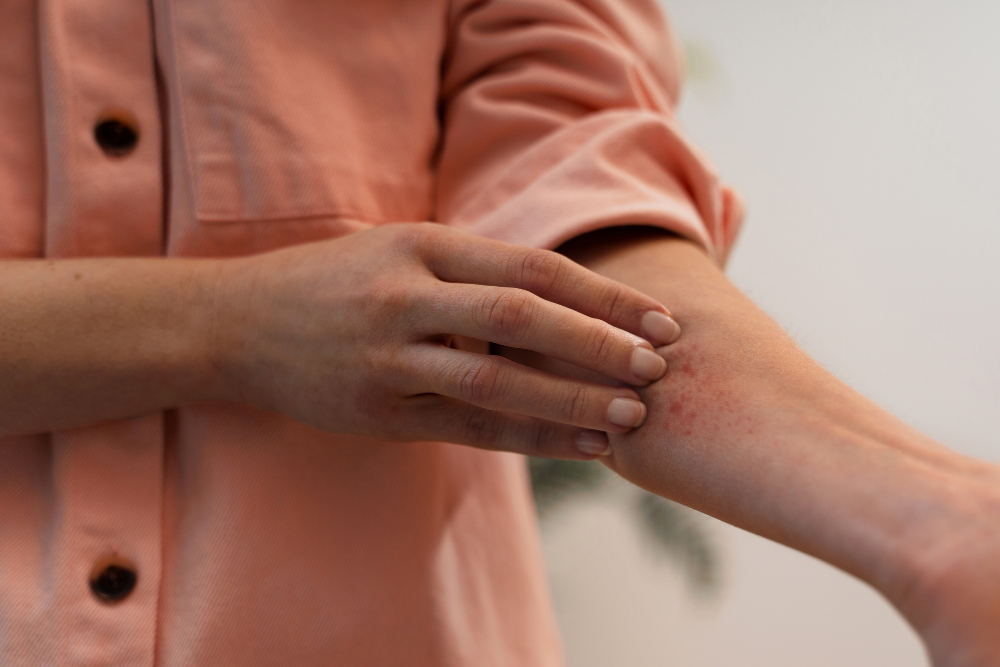Regular Eczema vs Weeping Eczema: Key Differences
Ever had your skin completely betray you? Like, one day it’s just dry and itchy, and the next morning, it’s sore, cracked, and kind of wet? If that sounds familiar, you might be dealing with something more than regular eczema.
In this blog, you’ll find weeping eczema explained in a way that makes sense. We’ll walk through the differences between regular and weeping eczema. How each one feels, and what you should actually do when things get worse. If you’ve been struggling with flare-ups and weird symptoms, you might find this blog beneficial.
What Regular Eczema Looks Like
If you’ve dealt with eczema, this probably sounds familiar. Your skin dries out, itches, turns red, and flakes everywhere. Sometimes it’s your hands. Other times it shows up behind your knees or on your neck. Either way, it sticks around longer than you’d like.
Most of the time, people manage it with basic things. Moisturizers. Fragrance-free soap. Maybe a cream from the pharmacy. It’s not fun, but it’s manageable. Furthermore, triggers can sneak up on you. One person reacts to stress. Someone else breaks out because of laundry detergent. Others get flare-ups from cold weather or allergies. It’s not a one-size-fits-all kind of thing.
And yet, regular eczema usually stays dry. That’s the main thing. It itches, but it doesn’t leak. Once it does, you’re probably dealing with something else.
When Eczema Starts Weeping: What’s Really Going On
Well, when those same patches of eczema suddenly start leaking fluid, it’s not just a bad flare-up. That’s weeping eczema, and it’s a lot more intense.
Most of the time, weeping eczema happens because of infection. Your skin barrier breaks down, usually after scratching, and bacteria get in. Next thing you know, there’s fluid, crusting, and way more pain than you’re used to.
Here’s what to look for:
- Blisters that fill with fluid and pop
- Skin that feels warm, swollen, and raw
- Yellowish crust forming over open area
- Burning, not just itching
- Possibly a fever if the infection spreads
At that point, your regular creams probably won’t help. And honestly, if you ignore it, things can get worse fast. I’ve seen people try to “wait it out,” and it only leads to more discomfort.
Let’s Compare: Regular Eczema vs Weeping Eczema
You might be wondering, “How can I actually tell the difference?” Fair question. They both itch, both cause redness, and both make your skin miserable.
But here’s how they’re different:
| Feature | Regular Eczema | Weeping Eczema |
| Texture | Dry and scaly | Wet, raw, or crusted over |
| Discomfort | Itchy and tight | Painful, burning, and oozing |
| Cause | Genetics, allergens, stress | Often caused by infection |
| Appearance | Red patches, flaky skin | Blisters, open sores, yellow crust |
| Treatment Needs | Moisturizers, mild steroids | Antibiotics, wet wraps, doctor’s care |
It’s easy to assume they’re the same condition, just worse or better. But that’s not the case. Weeping eczema is a sign that something new is happening, and your treatment needs to change, too.
Why You Can’t Treat Both the Same Way
Let’s be clear. Slathering regular moisturizer on weeping eczema probably won’t fix it. In fact, it could make things worse by sealing in bacteria.
Regular eczema responds well to:
- Thick moisturizers
- Avoiding known triggers
- Over-the-counter creams
Weeping eczema, on the other hand, might need:
- Medical-grade antibiotic ointments
- Wet wrap therapy
- Antiseptic cleansing
- Prescribed steroid or antibacterial treatments
Furthermore, if there’s an active infection, oral antibiotics might be the only way to get it under control. So, if your usual methods stop working, don’t push through it. Reach out to a dermatologist. Guessing rarely helps in these cases.
How It Affects More Than Just Your Skin
People don’t always talk about this part, but they should. Living with eczema, especially weeping eczema, isn’t just about skin discomfort. It affects everything.
You lose sleep. You cancel plans. You feel uncomfortable in your own body. And it’s frustrating, because even when you’re doing everything right, your skin might still flare up.
That’s the emotional side of it. The constant worry. The stress of trying a new product and hoping it won’t make things worse. It’s a lot.
But here’s the good news. Once you understand what you’re dealing with, you can take control again or at least stop feeling completely helpless.
So, When Should You Get Help?
There’s a difference between a bad skin day and something that needs medical attention. If your eczema starts leaking, crusting, or making you feel sick, don’t wait.
You should call a dermatologist if:
- You notice pus, swelling, or spreading
- It’s too painful to touch or sleep
- You have a fever or feel run down
- The affected area gets bigger in 24 to 48 hours
- Your regular treatments suddenly stop working
Additionally, if you’ve never had weeping eczema before and aren’t sure what’s going on, don’t try to diagnose it alone. A quick visit to a specialist could save you from weeks of discomfort.
Conclusion:
Understanding the difference between regular eczema and the weeping kind isn’t just useful, it’s essential. One is annoying but manageable. The other can be painful, infected, and way more serious.
Now that you’ve had weeping eczema explained, you know what signs to watch for and when to take action. The faster you respond, the quicker your skin can begin to heal.
Also, if you’re someone who deals with chronic skin conditions, it might be helpful to enroll in dermatology research. Some programs give you access to new treatments, expert monitoring, and better insight into what’s going on beneath the surface.
Your skin matters. And so does your peace of mind. Don’t wait for things to get worse. Take the first step toward healing now.
John Bailey

